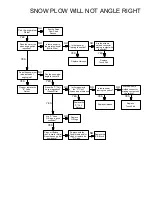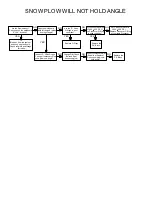
DIAGNOSTIC FLOW CHART FOR
E-57 & E-60 ELECTRO LIFT
®
UNITS
WITH TOUCH PAD
These charts are intended to be used as an aid in diagnosing problems on the Electro Lift
®
units. They are not a substitute for factory
training and experience. Be certain to read the General Information and Testing Tips sections before attempting any troubleshooting.
IMPORTANT: Maintenance and repairs must be performed with the moldboard on the ground.
General Information
Before any troubleshooting is started, make certain the following conditions are met.
1.
The moldboard is pointing straight ahead. This can often be done by coupling the left cylinder into the right cylinder and
pushing the moldboard by hand.
2.
The power angling cylinders must be installed correctly on to the A- frame. The left cylinder (Driver’s side) has a hose attached
with a male half of a coupler at the end; the right cylinder (Passenger side) has a hose attached with a female half of a coupler
at the end.
3.
The solenoid coils must be on their proper valve. (See drawing below).
TESTING TIPS
Many tests do not require removing the Electro Lift
®
unit from the vehicle. However, more thorough testing can be performed using
the Meyer Test Stand which allows direct pressure and amperage readings.
1.
Using a screwdriver or other small tool to check for magnetism of the solenoid coils “A”, “B” and “C”. Place the tool on the nut
securing the coil and have an assistant operate the switch. You should feel strong magnetic attraction.
2.
Use a test light or volt meter to determine whether there is power at the harness or switch.
3.
When determining AMP draw of the motor, always obtain the highest value possible, i.e, at maximum raise or maximum angle
with motor running.
4.
Proper rotation for the 4-1/2” motor (Fenner/Iskra) is clockwise by looking at the motor shaft from the bottom of the motor.
5.
The pump shaft of a good pump can be turned smoothly using two fingers. If it can’t be turn easily, the pump is too tight and
must be replaced.
6.
Pump pressure can be measured at an angle hose (note pressure at full angle) or in the pressure filter port (an adaptor is
necessary for the filter port).
7.
Flush the complete system including unit, hoses and power angling rams with a non wax (Napthenic) oil / cleaner. If kerosene
(Parrafinic) is used to flush the system, the system must be flushed again to remove any kerosene with a (Napthenic) based
oil / cleaner that is wax free.
BA
TTE
RY
PO
S
NE
G
10A
1
2
3
4
5
6
TO "A" SOLENOID
(BLACK WIRE)
TO "C" SOLENOID
(GREEN WIRE)
TO "B" SOLENOID
(RED WIRE)
TO MOTOR SOLENOID
(WHITE WIRE)
POWER TO SWITCH
(BLUE WIRE)
GROUND
(ORANGE WIRE)
END OF TOUCH PAD HARNESS
FUSE
PANEL
ON / OFF
SWITCH
POWER TO SWITCH
BLUE WIRE
WHITE
WIRE
SWITCH GROUND
ORANGE WIRE
GROUND
POWER
RED
B
GREEN
BLACK
C
A
E-60 & E-60H
The
current 22154 Electro-Touch Control
has been redesigned.
The Touch Pad now has raised buttons and its circuitry has been changed
from analog to digital, functions have not changed. For troubleshooting for
power at the solenoids do not disconnect wires. To check for power, prick the
wire through the insulation for testing. The
Electro-Touch Control
knows when
a short or an open connection occurs and will go into overload mode for the
function being activated. To reset the Touch Pad turn the switch on and off. The
Electro-Touch Control
will not operate if not wired properly as per the
installation instructions (1-690 & 1-759).
ON / OFF
SWITCH
POWER TO SWITCH
BLUE WIRE
WHITE
WIRE
SWITCH GROUND
ORANGE WIRE
GROUND
RED
POWER
"B"
DRA
IN
DRA
IN
D1
NEGATIVE
A2
POSITVE
BAT
TER
Y
POS
NEG
10
A
FUSE
PANEL
Ignition Switch
"ON"
E-57 & E-57H
























